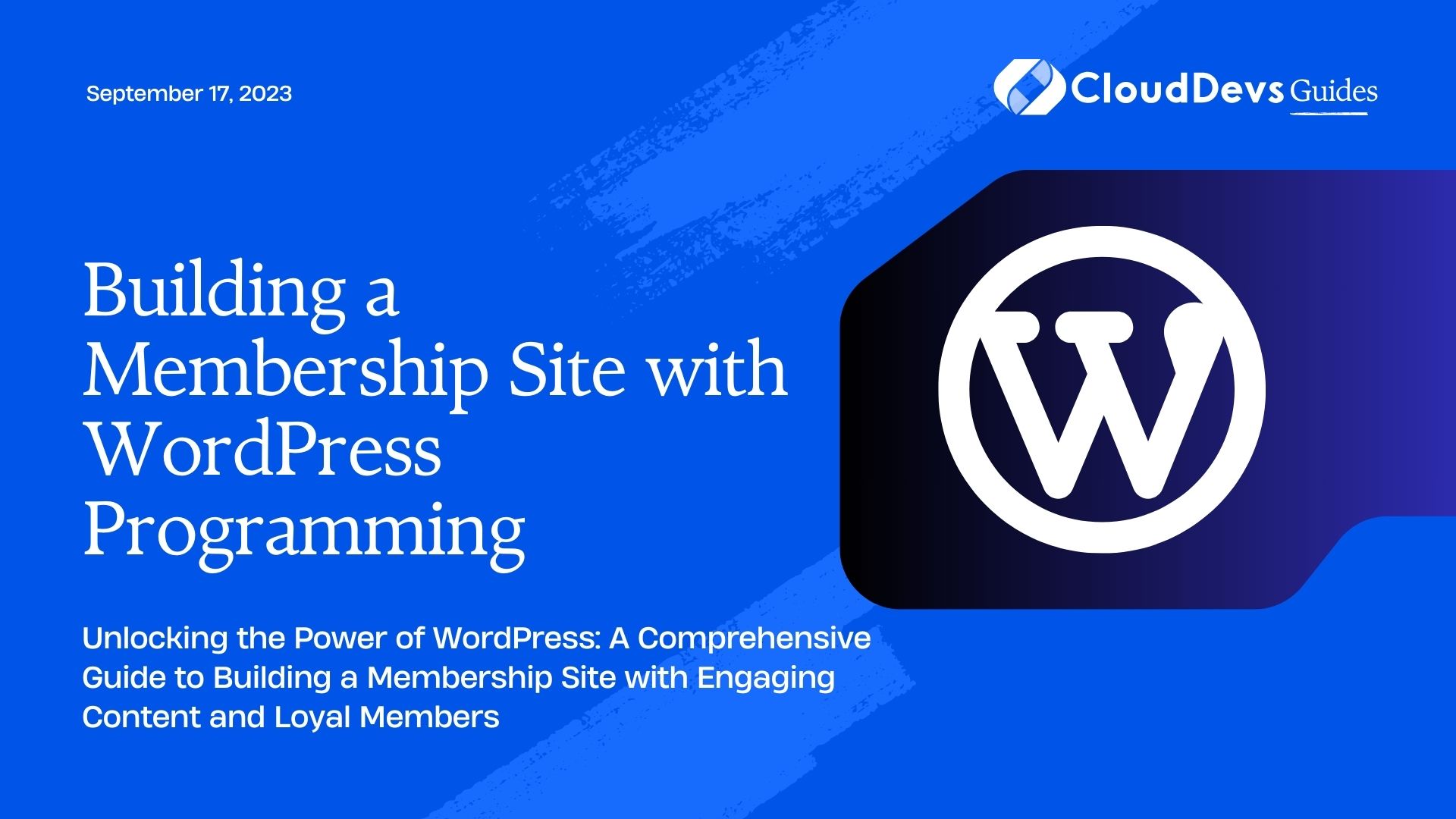Building a Membership Site with WordPress Programming
Building a membership site can be a game-changer for your online business. It not only offers exclusive content to your audience but also establishes a recurring revenue stream. WordPress, the most popular content management system (CMS), provides a versatile platform to create a membership site that suits your specific needs. In this comprehensive guide, we will walk you through the process of building a membership site with WordPress programming, step by step.
1. Understanding the Concept of Membership Sites
Before diving into the technical aspects, let’s explore the fundamental concepts of membership sites. A membership site is a private online platform where registered members can access exclusive content, products, or services. The content can be anything from premium articles, video courses, digital downloads, community forums, to member-only events.
Benefits of a Membership Site:
- Steady Revenue: A membership site offers recurring income, providing financial stability to your business.
- Community Building: You can foster a loyal community of like-minded individuals who share common interests.
- Enhanced Engagement: Exclusive content keeps your members engaged, increasing the chances of customer retention.
- Personalization: Tailor content based on member preferences, ensuring a more personalized user experience.
2. Setting Up a WordPress Website
Before proceeding with the membership functionality, ensure you have a WordPress website up and running. If you haven’t already, follow these steps:
- Domain and Hosting: Purchase a domain name that reflects your brand and choose a reliable hosting provider that meets your website’s needs.
- Install WordPress: Most hosting providers offer a one-click WordPress installation. Alternatively, you can manually install WordPress.
- Select a Theme: Choose a theme that complements your membership site’s purpose and design preferences. Many themes offer built-in support for membership features.
3. Essential WordPress Membership Plugins
To add membership functionality to your WordPress site, you’ll need plugins. Here are some popular ones to consider:
1. MemberPress: MemberPress is a robust membership plugin that allows you to create and manage memberships, restrict access to content, and handle payments seamlessly.
Sample code for creating a basic membership plan with MemberPress:
php // Create a membership plan $membership = new MeprProduct(); $membership->post_title = 'Silver Membership'; $membership->price = 19.99; // Set the price for the membership $membership->period = '1 YEAR'; // Set the membership duration $membership->save();
2. LearnDash: If your membership site focuses on e-learning, LearnDash is an excellent choice. It enables you to create and sell online courses with ease.
Sample code for creating a course with LearnDash:
php
// Create a new course
$course_id = learndash_create_course([
'post_title' => 'Introduction to WordPress Programming',
'post_content' => 'This course will introduce you to WordPress programming.',
'post_status' => 'publish',
]);
3. Paid Memberships Pro: This plugin offers a range of membership features, including content restriction, payment gateway integrations, and customizable membership levels.
Sample code for restricting content with Paid Memberships Pro:
php
// Restrict access to specific content
function my_pmp_restrict_content() {
global $post;
if (is_singular('post') && !pmpro_hasMembershipAccess($post->ID)) {
wp_redirect(pmpro_url('levels'));
exit;
}
}
add_action('template_redirect', 'my_pmp_restrict_content');
4. Creating Membership Levels and Access Rules
One of the key aspects of a membership site is defining membership levels and access rules. Here’s how to do it:
- Determine Membership Tiers: Decide on the different membership levels you want to offer (e.g., Basic, Silver, Gold).
- Content Access Control: Set up rules to control access to different content based on membership levels.
Sample code for content restriction based on membership levels:
php
// Restrict content based on membership level
function my_restrict_content_based_on_membership() {
if (!mepr_user_has_access(123, get_current_user_id())) { // 123 is the membership ID for Gold level
echo 'You must be a Gold member to access this content.';
} else {
// Display the content here
}
}
add_action('template_redirect', 'my_restrict_content_based_on_membership');
5. Implementing Payment Gateways
To accept payments for your membership subscriptions, integrate popular payment gateways with your site.
1. PayPal: A widely used and trusted payment gateway.
Sample code for PayPal integration:
php
// PayPal payment processing function
function process_paypal_payment() {
// Add your PayPal payment processing logic here
}
add_action('wp_ajax_process_paypal_payment', 'process_paypal_payment');
add_action('wp_ajax_nopriv_process_paypal_payment', 'process_paypal_payment');
2. Stripe: Another popular payment gateway known for its simplicity and security.
Sample code for Stripe integration:
php
// Stripe payment processing function
function process_stripe_payment() {
// Add your Stripe payment processing logic here
}
add_action('wp_ajax_process_stripe_payment', 'process_stripe_payment');
add_action('wp_ajax_nopriv_process_stripe_payment', 'process_stripe_payment');
6. Designing a User-friendly Interface
A smooth user experience is crucial for a successful membership site. Design an intuitive interface to facilitate user navigation.
- User Registration and Login: Implement a straightforward registration and login process.
- User Dashboard: Create a personalized dashboard for members to access their content, account settings, and progress tracking.
- Mobile Responsiveness: Ensure your site is mobile-friendly to cater to users on various devices.
7. Engaging and Delivering Value
To retain members and keep them engaged, focus on delivering value and fostering a sense of community.
- Regularly Update Content: Offer fresh and valuable content to keep members coming back.
- Exclusive Events: Organize member-only webinars, Q&A sessions, or live events to enhance engagement.
- Community Forums: Provide a platform for members to interact, share ideas, and seek support.
Conclusion
Congratulations! You have now learned the essentials of building a membership site with WordPress programming. By leveraging the power of WordPress, essential plugins, and the right payment gateways, you can create a thriving membership site that attracts and retains loyal members. Remember, the key to success lies in consistently delivering value to your community. So, start building your membership site today and unlock the potential for long-term growth and profitability for your online business.
Table of Contents








